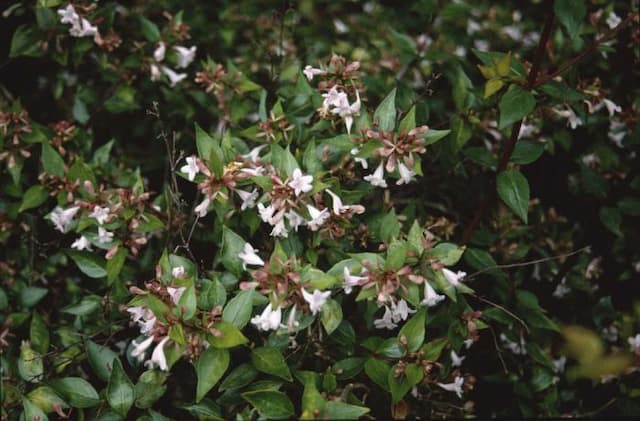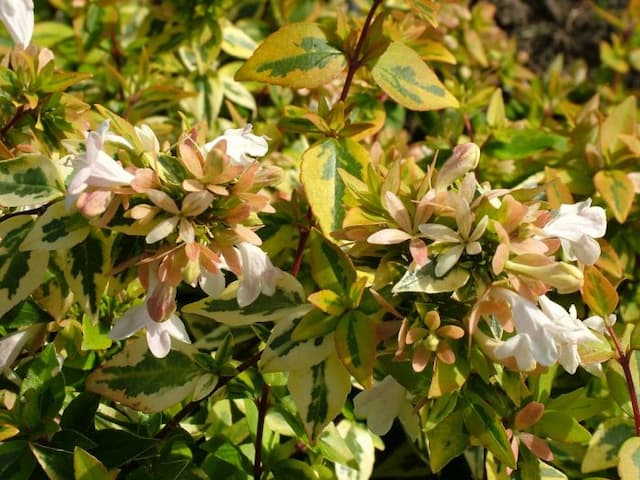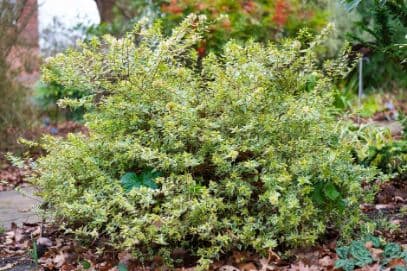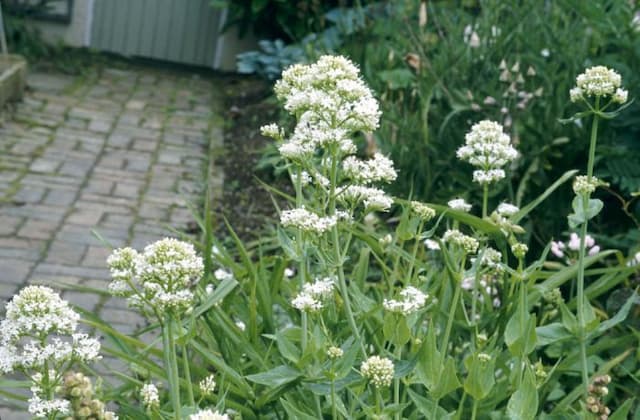Honeyberry Lonicera caerulea var. kamtschatica

ABOUT
Commonly known as honeyberry, this plant is a deciduous shrub with a bushy growth habit. Honeyberry exhibits lance-shaped leaves that are blue-green in color and have a slight bluish tinge underneath. The plant puts out small, trumpet-shaped flowers which are creamy white to yellow in color and appear in pairs. These blossoms are a harbinger of spring as they typically emerge before the leaves fully unfurl. As the seasons progress, the flowers give way to elongated, blueberry-like fruit. The fruit's skin is smooth, with a blue-purple hue often likened to that of blueberries, and it contains tiny, edible seeds within its juicy flesh. When the berries are ripe, usually in early summer, they offer both a sweet and tangy flavor which is relished by both humans and wildlife alike. Honeyberry's foliage turns yellow in the fall, providing a lovely contrast against the often gray and barren landscape as the colder months set in.
About this plant
 Names
NamesFamily
Caprifoliaceae.
Synonyms
Honeyberry, Haskap, Blue Honeysuckle, Sweetberry Honeysuckle, Kamchatka Honeysuckle, Edible Honeysuckle.
Common names
Lonicera edulis var. kamtschatica, Lonicera caerulea var. edulis, Lonicera turczaninowii.
 Toxicity
ToxicityTo humans
Lonicera caerulea var. kamtschatica, known commonly as honeyberry, is not typically considered toxic to humans. The berries are edible and consumed for their nutritional values. However, like any fruit, overconsumption may cause mild gastrointestinal upset. There are no significant toxic compounds known in honeyberries that would cause poisoning or severe symptoms in humans if consumed in reasonable quantities.
To pets
For pets, the honeyberry is also not generally considered toxic. It is unlikely to cause poisoning in animals if they consume the fruit. However, it's always important to introduce new foods to pets gradually and in moderation to prevent any potential gastrointestinal upset that can occur from eating something unfamiliar. Always consult with a veterinarian if you are unsure about feeding any type of plant or fruit to your pets.
 Characteristics
CharacteristicsLife cycle
Perennials
Foliage type
Deciduous
Color of leaves
Green
Flower color
Yellow-white
Height
6 feet (1.8 meters)
Spread
4 feet (1.2 meters)
Plant type
Shrub
Hardiness zones
2
Native area
Siberia
Benefits
 General Benefits
General Benefits- Edible Berries: The plant produces tasty blueberry-like fruits that are rich in vitamins and antioxidants.
- Ornamental Value: With its attractive flowers and berries, Lonicera caerulea var. kamtschatica adds visual interest to gardens.
- Hardiness: This variety is known for its resilience to cold temperatures, making it suitable for northern climates.
- Pollinator Attraction: Flowers of the honeyberry can attract bees and butterflies, promoting pollination in the garden.
- Wildlife Habitat: The dense shrubbery offers shelter and the berries provide food for various bird species and wildlife.
- Low Maintenance: Once established, honeyberries require minimal care, making them ideal for low-maintenance landscaping.
- Erosion Control: The plants' root systems help stabilize soil and prevent erosion.
 Medical Properties
Medical Properties- Antioxidant: Lonicera caerulea, commonly known as honeyberry, has been found to contain high levels of antioxidants which may help in protecting cells from oxidative stress.
- Anti-inflammatory: Some studies suggest that compounds in honeyberry have anti-inflammatory effects, which could aid in reducing inflammation-related symptoms in various conditions.
- Antimicrobial: Extracts from honeyberry have been demonstrated to have antimicrobial properties against certain bacteria and fungi.
- Cardiovascular health: Honeyberry's high content of flavonoids and other phenolic compounds may contribute to heart health by improving blood lipid profiles and exerting cardioprotective effects.
- Diabetes management: Honeyberry may have a role in managing blood sugar levels due to its potential impact on glucose metabolism.
- Eye health: The plant contains zeaxanthin and lutein, antioxidants that are beneficial for eye health and may help to prevent age-related macular degeneration.
- Immune support: Components of honeyberry might strengthen the immune system, although specific research on this effect is limited.
 Air-purifying Qualities
Air-purifying QualitiesThis plant is not specifically known for air purifying qualities.
 Other Uses
Other Uses- Honeyberry wood can be utilized in small woodworking projects for its fine grain and interesting color, though it is not commercially common.
- Leaves from the honeyberry plant can be used to create a natural yellow dye for textiles, owing to their pigmentation.
- Due to its dense growth habit, honeyberry can be planted as a low, informal hedge or as part of a mixed shrub border for landscaping.
- The flowers provide an ornamental feature in the garden when the honeyberry plant is in bloom, adding aesthetic value.
- As a wildlife plant, honeyberry attracts pollinators like bees and butterflies to the garden, enhancing pollinator biodiversity.
- Fruit from the honeyberry can be used in winemaking to impart a unique flavor profile to fruit wines or meads.
- Dried honeyberry leaves can serve as an ingredient for potpourri, contributing a light fragrance and adding texture.
- The honeyberry plant can be used in bonsai cultivation, offering an alternative and unique species for enthusiasts to shape and grow.
- When pruned correctly, honeyberry bushes can be shaped into decorative forms or even topiaries for garden art.
- Fallen honeyberry foliage can add to compost piles, providing green material that will decay to enrich the soil naturally.
Interesting Facts
 Feng Shui
Feng ShuiThe Honeyberry is not used in Feng Shui practice.
 Zodiac Sign Compitability
Zodiac Sign CompitabilityThe Honeyberry is not used in astrology practice.
 Plant Symbolism
Plant Symbolism- Enduring Love: Also known as Honeyberry, this plant is often associated with steadfast love due to its resilience and the sweet-tasting edible berries it produces, which can be reminiscent of the sweetness of a loving relationship.
- Devotion: The hardy nature of the Honeyberry symbolizes devotion, as the plant can withstand harsh conditions, much like devoted individuals stand by each other through challenges.
- New Beginnings: Honeyberries are among the first berries to ripen in spring, symbolizing new beginnings and the renewal that comes with the changing seasons.
- Unity: This plant's ability to grow in clusters with others often symbolizes the importance of unity and the idea that strength and productivity can come from being part of a collective.
 Water
WaterFor the Honeyberry (Lonicera caerulea var. kamtschatica), water regularly to keep the soil consistently moist but not saturated. As a general rule, water deeply once a week with approximately 1 to 2 gallons per plant, depending on the size. During hot or dry weather, increase the frequency to twice a week. Ensure that the water reaches the root zone without waterlogging the soil. Reduce watering in the winter when the plant is dormant.
 Light
LightHoneyberry plants prefer full sun to partial shade, with at least six hours of direct sunlight daily for optimal fruit production. The best spot for planting Honeyberries would be an area that receives morning sunlight and some afternoon shade, especially in hotter climates.
 Temperature
TemperatureHoneyberry plants are quite cold-hardy and can withstand temperatures as low as -40°F, making them suitable for colder climates. The ideal growing temperature range is between 55°F and 75°F. While they are cold tolerant, sustained temperatures over 85°F can stress the plants, so providing some afternoon shade in hotter regions is beneficial.
 Pruning
PruningHoneyberry plants should be pruned to maintain shape and encourage healthy growth. Prune in the late winter or early spring before new growth starts. Remove any dead, damaged, or overcrowded branches to improve air circulation and sunlight exposure. Pruning should be done annually for best results but can be adjusted depending on the plant's performance and size.
 Cleaning
CleaningAs needed
 Soil
SoilHoneyberry (Lonicera caerulea var. kamtschatica) prefers well-drained soil with high organic matter content; a mix of loam, peat, and sand can work well. The ideal soil pH for honeyberries is slightly acidic, around 5.5 to 7.
 Repotting
RepottingHoneyberry plants typically do not require frequent repotting; they can thrive in the same spot for several years. However, if the plant is in a container, repot once every 2-3 years to refresh the soil and provide room for growth.
 Humidity & Misting
Humidity & MistingHoneyberry plants are adaptable and do not require high humidity levels; average atmospheric humidity is sufficient for their growth.
 Suitable locations
Suitable locationsIndoor
Provide bright light and cool temperatures.
Outdoor
Plant in full sun to partial shade; shelter from strong winds.
Hardiness zone
2-7 USDA
 Life cycle
Life cycleLonicera caerulea var. kamtschatica, commonly known as honeyberry, begins its life cycle as a seed, which requires stratification—a period of cold exposure—to germinate. Once the seed sprouts, it develops into a seedling with initial leaves, and over time, it grows into a mature shrub with woody stems. The plant enters a vegetative stage where it focuses on leaf expansion and the development of strong root systems. Upon reaching maturity after a few years, the honeyberry produces flowers in early spring, which are usually followed by fruit set when pollination occurs. The berries ripen around late spring to early summer, which is when they are harvested. After fruiting, the plant enters a period of dormancy during the winter months before the cycle starts again with new growth in the spring.
 Propogation
PropogationPropogation time
Spring
The most popular method of propagating the Honeyberry, Lonicera caerulea var. kamtschatica, is through softwood cuttings. This is typically done in late spring or early summer when new growth is green and flexible. Cuttings should be 4-6 inches long and contain at least two pairs of leaves. The lower leaves are removed, and the cut end is dipped in rooting hormone before being placed in a well-draining soil mix. The cuttings must be kept moist and in high humidity, which can be achieved by covering them with a plastic bag. It usually takes about 4 to 8 weeks for cuttings to root, after which they can be transplanted to a larger container or directly in the garden.









